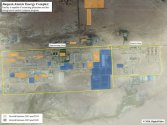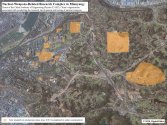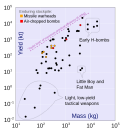That's my question, too. Can you replace the WgPu in the primary with HEU? Since China has so little WgPu, could it simply design primaries using HEU instead, even if it meant heavier warhead?If WgPu is not used at all, instead purely HEU, how much HEU would be needed for 535 and 575 ?
China is estimated only have 17 tonnes of HEU and 3.5 tonnes of WgPu ... which is very low in my opinion .. should have 5-6x more
You are using an out of date browser. It may not display this or other websites correctly.
You should upgrade or use an alternative browser.
You should upgrade or use an alternative browser.
China Ballistic Missiles and Nuclear Arms Thread
- Thread starter peace_lover
- Start date
- Status
- Not open for further replies.
I don't really understand this line of thinking. The research, development, production and fielding of strategic warheads is informed by acquisition needs as well as TRL maturing for the actual technologies and designs at hand.
Strategic precursor material efficiency is not and should not be a concern or deviating factor for a country like China in 2023.
Strategic precursor material efficiency is not and should not be a concern or deviating factor for a country like China in 2023.
Just found out this under reported news back in 2020, it seems significant after obvious ICBM expansion.
It is new to me that NATO intelligence claiming that China is building a new nuclear reactor in the old plutonium facility. I am not a nuclear expert here but it seems to me that you won't need a live reactor in reprocessing plant unless you want to produce WGPu. The old reactor was based on 1950s Soviet design and produced about 200-400kg/yr WGPu, shutdown decades ago.
Plutonium production facility, doubled in size compared with 2010.

And modest expansion in CAEP's warhead assembly facility in Mianyang, not entirely for warhead production ofc. They are demolishing nearby residential complex recently possibly paving way for another expansion or modernization of facilities.

It is new to me that NATO intelligence claiming that China is building a new nuclear reactor in the old plutonium facility. I am not a nuclear expert here but it seems to me that you won't need a live reactor in reprocessing plant unless you want to produce WGPu. The old reactor was based on 1950s Soviet design and produced about 200-400kg/yr WGPu, shutdown decades ago.
Plutonium production facility, doubled in size compared with 2010.

And modest expansion in CAEP's warhead assembly facility in Mianyang, not entirely for warhead production ofc. They are demolishing nearby residential complex recently possibly paving way for another expansion or modernization of facilities.

Depends on what you are hitting. MIRVs were such a big thing in the cold war because they allowed the attacker to target multiple counterforce targets (bomber bases, silos, SSBNs in piers, depots, etc...) with a single missile. This was a huge thing in the era when early warning and C3 weren't very reliable. It meant most of your nuclear arsenal could be destroyed by a small fraction of adversary missiles.Still very much relevant -weapon wise I'd rather have 3 -250 kiloton warheads rather than 1 -single 1000 kiloton (1Megaton) warhead with commensurately accurate cep.Any news on the new "super-fuze" technology-this would mean even more accurate -thus lower yield warheads with same deadliness.
If you are blowing up cities MIRVs don't matter much. Because of geometric and MIRV-bus-related constraints, you get more yield per unit of payload weight as you decrease the number of warheads your missile carries.
Let's imagine a DF-41 with 10 150 kt warheads, which is realistic according to what we know. With decoys, the MIRV bus and re-entry vehicles, the total payload would be around 1800 kg. It is quite realistic to get 7 MT from a 1800 kg single warhead payload.

You can see this relationship in the R-36M2 missile too. It can carry 10 1 MT warheads to an 11000 km distance or it can carry a single 20 MT warhead to a 16000 km distance.
So there isn't much gain in increasing the number of warheads if you don't pursue counterforce.
3 250 kTs might take 3x2 kg WGP while the 1000 kT might take 4 kg.Still very much relevant -weapon wise I'd rather have 3 -250 kiloton warheads rather than 1 -single 1000 kiloton (1Megaton) warhead with commensurately accurate cep.Any news on the new "super-fuze" technology-this would mean even more accurate -thus lower yield warheads with same deadliness.
Agreed which is why I think that in the short term (next 3 years, more limited WGP supplies while new reprocessing spins up) they'll be making more of the 650 kTs as single shots for ensuring minimum deterrent while as WGP ramps up, the 150 kTs will be deployed more. Of course there should also be interchangable buses.Depends on what you are hitting. MIRVs were such a big thing in the cold war because they allowed the attacker to target multiple counterforce targets (bomber bases, silos, SSBNs in piers, depots, etc...) with a single missile. This was a huge thing in the era when early warning and C3 weren't very reliable. It meant most of your nuclear arsenal could be destroyed by a small fraction of adversary missiles.
If you are blowing up cities MIRVs don't matter much. Because of geometric and MIRV-bus-related constraints, you get more yield per unit of payload weight as you decrease the number of warheads your missile carries.
Let's imagine a DF-41 with 10 150 kt warheads, which is realistic according to what we know. With decoys, the MIRV bus and re-entry vehicles, the total payload would be around 1800 kg. It is quite realistic to get 7 MT from a 1800 kg single warhead payload.
View attachment 108943
You can see this relationship in the R-36M2 missile too. It can carry 10 1 MT warheads to an 11000 km distance or it can carry a single 20 MT warhead to a 16000 km distance.
So there isn't much gain in increasing the number of warheads if you don't pursue counterforce.
It is if you need more weapons NOW, not in 2-3 years, but NOW. And yes it is needed NOW.I don't really understand this line of thinking. The research, development, production and fielding of strategic warheads is informed by acquisition needs as well as TRL maturing for the actual technologies and designs at hand.
Strategic precursor material efficiency is not and should not be a concern or deviating factor for a country like China in 2023.
China has enough weapons grade plutonium stockpiled for NOW.It is if you need more weapons NOW, not in 2-3 years, but NOW. And yes it is needed NOW.
1.5 tons is only enough for 750 warheads at 2 kg per warhead. It's not worth it to spend WGP on 150 kTs at 1.5 kg each when 2 kg gets you 650 kT yield.China has enough weapons grade plutonium stockpiled for NOW.
This thread will be closed and replaced with two new threads to better organize discussions about Chinese ballistic missile and nuclear topics
This thread will be for primarily Nuclear missiles (ICBMs, SLBMs) and nuclear weapons developments
This thread will be for other types of ballistic missile, including IRBMs and SRBMs, and will include weapons in this category which may have the option to fit nuclear warheads but which the primary warheads are conventional.
Essentially, this will allow discussion about "nuclear weapons" and intercontinental range ballistic missile delivery systems -- to be separated from everything else whether it be SRBMs, IRBMs and other weapons whose primary warheads are conventional (even if they have the option of being fitted with a nuclear warhead).
This thread will be for primarily Nuclear missiles (ICBMs, SLBMs) and nuclear weapons developments
China ICBM/SLBM, nuclear arms thread
Continued from previous thread here: https://www.sinodefenceforum.com/t/china-ballistic-missiles-and-nuclear-arms-thread.5881/page-818#post-956941 This thread will be for primarily Nuclear missiles (ICBMs, SLBMs) and nuclear weapons developments A separate thread will be for other types of...
www.sinodefenceforum.com
This thread will be for other types of ballistic missile, including IRBMs and SRBMs, and will include weapons in this category which may have the option to fit nuclear warheads but which the primary warheads are conventional.
PLA IRBM and SRBM (and non-ICBM/SLBM) thread
Continued from previous thread here: https://www.sinodefenceforum.com/t/china-ballistic-missiles-and-nuclear-arms-thread.5881/page-818#post-956941 This thread will be for IRBMs and SRBMs, and will include weapons in this category which may have the option to fit nuclear warheads but which the...
www.sinodefenceforum.com
Essentially, this will allow discussion about "nuclear weapons" and intercontinental range ballistic missile delivery systems -- to be separated from everything else whether it be SRBMs, IRBMs and other weapons whose primary warheads are conventional (even if they have the option of being fitted with a nuclear warhead).
- Status
- Not open for further replies.
